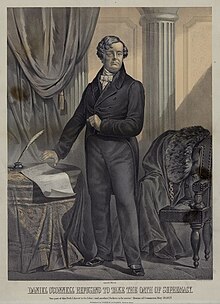
Caption: "One part of this Oath I know to be false; and another I believe to be untrue. House of Commons, May 20, 1829."
The Oath of Supremacy required any person taking public or church office in the Kingdom of England, or in its subordinate Kingdom of Ireland, to swear allegiance to the monarch as Supreme Governor of the Church. Failure to do so was to be treated as treasonable. The Oath of Supremacy was originally imposed by King Henry VIII of England through the Act of Supremacy 1534, but repealed by his elder daughter, Queen Mary I of England, and reinstated under Henry's other daughter and Mary's half-sister, Queen Elizabeth I of England, under the Act of Supremacy 1558. The Oath was later extended to include Members of Parliament (MPs) and people studying at universities. In 1537, the Irish Supremacy Act was passed by the Parliament of Ireland, establishing Henry VIII as the supreme head of the Church of Ireland. As in England, a commensurate Oath of Supremacy was required for admission to offices.
In 1801, retained by the United Kingdom of Great Britain and Ireland, the oath continued to bar Catholics from Parliament until substantially amended by the Roman Catholic Relief Act of 1829. The requirement to take the oath for Oxford University students was not removed until the Oxford University Act 1854.